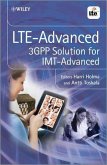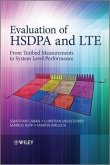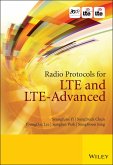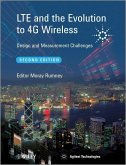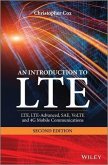Design, Deployment and Performance of 4G-LTE Networks (eBook, PDF)
A Practical Approach


Alle Infos zum eBook verschenken

Design, Deployment and Performance of 4G-LTE Networks (eBook, PDF)
A Practical Approach
- Format: PDF
- Merkliste
- Auf die Merkliste
- Bewerten Bewerten
- Teilen
- Produkt teilen
- Produkterinnerung
- Produkterinnerung

Hier können Sie sich einloggen

Bitte loggen Sie sich zunächst in Ihr Kundenkonto ein oder registrieren Sie sich bei bücher.de, um das eBook-Abo tolino select nutzen zu können.
This book provides an insight into the key practical aspects and best practice of 4G-LTE network design, performance, and deployment Design, Deployment and Performance of 4G-LTE Networks addresses the key practical aspects and best practice of 4G networks design, performance, and deployment. In addition, the book focuses on the end-to-end aspects of the LTE network architecture and different deployment scenarios of commercial LTE networks. It describes the air interface of LTE focusing on the access stratum protocol layers: PDCP, RLC, MAC, and Physical Layer. The air interface described in…mehr
- Geräte: PC
- mit Kopierschutz
- eBook Hilfe
- Größe: 37.72MB
![Design, Deployment and Performance of 4G-LTE Networks (eBook, ePUB) Design, Deployment and Performance of 4G-LTE Networks (eBook, ePUB)]() Ayman ElnasharDesign, Deployment and Performance of 4G-LTE Networks (eBook, ePUB)89,99 €
Ayman ElnasharDesign, Deployment and Performance of 4G-LTE Networks (eBook, ePUB)89,99 €![LTE Advanced (eBook, PDF) LTE Advanced (eBook, PDF)]() LTE Advanced (eBook, PDF)80,99 €
LTE Advanced (eBook, PDF)80,99 €![Evaluation of HSDPA and LTE (eBook, PDF) Evaluation of HSDPA and LTE (eBook, PDF)]() Markus RuppEvaluation of HSDPA and LTE (eBook, PDF)107,99 €
Markus RuppEvaluation of HSDPA and LTE (eBook, PDF)107,99 €![Radio Protocols for LTE and LTE-Advanced (eBook, PDF) Radio Protocols for LTE and LTE-Advanced (eBook, PDF)]() Seungjune YiRadio Protocols for LTE and LTE-Advanced (eBook, PDF)111,99 €
Seungjune YiRadio Protocols for LTE and LTE-Advanced (eBook, PDF)111,99 €![Heterogeneous Networks in LTE-Advanced (eBook, PDF) Heterogeneous Networks in LTE-Advanced (eBook, PDF)]() Joydeep AcharyaHeterogeneous Networks in LTE-Advanced (eBook, PDF)91,99 €
Joydeep AcharyaHeterogeneous Networks in LTE-Advanced (eBook, PDF)91,99 €![LTE and the Evolution to 4G Wireless (eBook, PDF) LTE and the Evolution to 4G Wireless (eBook, PDF)]() Agilent TechnologiesLTE and the Evolution to 4G Wireless (eBook, PDF)89,99 €
Agilent TechnologiesLTE and the Evolution to 4G Wireless (eBook, PDF)89,99 €![An Introduction to LTE (eBook, PDF) An Introduction to LTE (eBook, PDF)]() Christopher CoxAn Introduction to LTE (eBook, PDF)66,99 €
Christopher CoxAn Introduction to LTE (eBook, PDF)66,99 €-
-
-
Dieser Download kann aus rechtlichen Gründen nur mit Rechnungsadresse in A, B, BG, CY, CZ, D, DK, EW, E, FIN, F, GR, HR, H, IRL, I, LT, L, LR, M, NL, PL, P, R, S, SLO, SK ausgeliefert werden.
- Produktdetails
- Verlag: John Wiley & Sons
- Seitenzahl: 608
- Erscheinungstermin: 13. März 2014
- Englisch
- ISBN-13: 9781118703458
- Artikelnr.: 40614336
- Verlag: John Wiley & Sons
- Seitenzahl: 608
- Erscheinungstermin: 13. März 2014
- Englisch
- ISBN-13: 9781118703458
- Artikelnr.: 40614336
Acronyms xxi 1 LTE Network Architecture and Protocols 1 Ayman Elnashar and
Mohamed A. El-saidny 1.1 Evolution of 3GPP Standards 2 1.1.1 3GPP Release
99 3 1.1.2 3GPP Release 4 3 1.1.3 3GPP Release 5 3 1.1.4 3GPP Release 6 4
1.1.5 3GPP Release 7 4 1.1.6 3GPP Release 8 5 1.1.7 3GPP Release 9 and
Beyond 5 1.2 Radio Interface Techniques in 3GPP Systems 6 1.2.1 Frequency
Division Multiple Access (FDMA) 6 1.2.2 Time Division Multiple Access
(TDMA) 6 1.2.3 Code Division Multiple Access (CDMA) 7 1.2.4 Orthogonal
Frequency Division Multiple Access (OFDMA) 7 1.3 Radio Access Mode
Operations 7 1.3.1 Frequency Division Duplex (FDD) 8 1.3.2 Time Division
Duplex (TDD) 8 1.4 Spectrum Allocation in UMTS and LTE 8 1.5 LTE Network
Architecture 10 1.5.1 Evolved Packet System (EPS) 10 1.5.2 Evolved Packet
Core (EPC) 11 1.5.3 Evolved Universal Terrestrial Radio Access Network
(E-UTRAN) 13 1.5.4 LTE User Equipment 13 1.6 EPS Interfaces 14 1.6.1 S1-MME
Interface 14 1.6.2 LTE-Uu Interface 15 1.6.3 S1-U Interface 17 1.6.4 S3
Interface (SGSN-MME) 18 1.6.5 S4 (SGSN to SGW) 18 1.6.6 S5/S8 Interface 19
1.6.7 S6a (Diameter) 21 1.6.8 S6b Interface (Diameter) 21 1.6.9 S6d
(Diameter) 22 1.6.10 S9 Interface (H-PCRF-VPCRF) 23 1.6.11 S10 Interface
(MME-MME) 23 1.6.12 S11 Interface (MME-SGW) 23 1.6.13 S12 Interface 23
1.6.14 S13 Interface 24 1.6.15 SGs Interface 24 1.6.16 SGi Interface 25
1.6.17 Gx Interface 26 1.6.18 Gy and Gz Interfaces 27 1.6.19 DNS Interface
27 1.6.20 Gn/Gp Interface 27 1.6.21 SBc Interface 28 1.6.22 Sv Interface 28
1.7 EPS Protocols and Planes 29 1.7.1 Access and Non-Access Stratum 29
1.7.2 Control Plane 29 1.7.3 User Plane 30 1.8 EPS Procedures Overview 31
1.8.1 EPS Registration and Attach Procedures 31 1.8.2 EPS Quality of
Service (QoS) 34 1.8.3 EPS Security Basics 36 1.8.4 EPS Idle and Active
States 38 1.8.5 EPS Network Topology for Mobility Procedures 39 1.8.6 EPS
Identifiers 44 References 44 2 LTE Air Interface and Procedures 47 Mohamed
A. El-saidny 2.1 LTE Protocol Stack 47 2.2 SDU and PDU 48 2.3 LTE Radio
Resource Control (RRC) 50 2.4 LTE Packet Data Convergence Protocol Layer
(PDCP) 52 2.4.1 PDCP Architecture 53 2.4.2 PDCP Data and Control SDUs 53
2.4.3 PDCP Header Compression 54 2.4.4 PDCP Ciphering 54 2.4.5 PDCP
In-Order Delivery 54 2.4.6 PDCP in LTE versus HSPA 55 2.5 LTE Radio Link
Control (RLC) 55 2.5.1 RLC Architecture 56 2.5.2 RLC Modes 57 2.5.3 Control
and Data PDUs 60 2.5.4 RLC in LTE versus HSPA 60 2.6 LTE Medium Access
Control (MAC) 61 2.7 LTE Physical Layer (PHY) 61 2.7.1 HSPA(+) Channel
Overview 61 2.7.2 General LTE Physical Channels 71 2.7.3 LTE Downlink
Physical Channels 71 2.7.4 LTE Uplink Physical Channels 72 2.8 Channel
Mapping of Protocol Layers 73 2.8.1 E-UTRAN Channel Mapping 73 2.8.2 UTRAN
Channel Mapping 76 2.9 LTE Air Interface 76 2.9.1 LTE Frame Structure 76
2.9.2 LTE Frequency and Time Domains Structure 76 2.9.3 OFDM Downlink
Transmission Example 80 2.9.4 Downlink Scheduling 81 2.9.5 Uplink
Scheduling 88 2.9.6 LTE Hybrid Automatic Repeat Request (HARQ) 89 2.10 Data
Flow Illustration Across the Protocol Layers 90 2.10.1 HSDPA Data Flow 90
2.10.2 LTE Data Flow 91 2.11 LTE Air Interface Procedures 92 2.11.1
Overview 92 2.11.2 Frequency Scan and Cell Identification 92 2.11.3
Reception of Master and System Information Blocks (MIB and SIB) 93 2.11.4
Random Access Procedures (RACH) 94 2.11.5 Attach and Registration 95 2.11.6
Downlink and Uplink Data Transfer 96 2.11.7 Connected Mode Mobility 96
2.11.8 Idle Mode Mobility and Paging 99 References 100 3 Analysis and
Optimization of LTE System Performance 103 Mohamed A. El-saidny 3.1
Deployment Optimization Processes 104 3.1.1 Profiling Device and User
Behavior in the Network 105 3.1.2 Network Deployment Optimization Processes
107 3.1.3 Measuring the Performance Targets 108 3.1.4 LTE Troubleshooting
Guidelines 119 3.2 LTE Performance Analysis Based on Field Measurements 123
3.2.1 Performance Evaluation of Downlink Throughput 127 3.2.2 Performance
Evaluation of Uplink Throughput 131 3.3 LTE Case Studies and
Troubleshooting 134 3.3.1 Network Scheduler Implementations 135 3.3.2 LTE
Downlink Throughput Case Study and Troubleshooting 136 3.3.3 LTE Uplink
Throughput Case Studies and Troubleshooting 139 3.3.4 LTE Handover Case
Studies 146 3.4 LTE Inter-RAT Cell Reselection 153 3.4.1 Introduction to
Cell Reselection 155 3.4.2 LTE to WCDMA Inter-RAT Cell Reselection 155
3.4.3 WCDMA to LTE Inter-RAT Cell Reselection 160 3.5 Inter-RAT Cell
Reselection Optimization Considerations 165 3.5.1 SIB-19 Planning Strategy
for UTRAN to E-UTRAN Cell Reselection 165 3.5.2 SIB-6 Planning Strategy for
E-UTRAN to UTRAN Cell Reselection 167 3.5.3 Inter-RAT Case Studies from
Field Test 168 3.5.4 Parameter Setting Trade-off 174 3.6 LTE to LTE
Inter-frequency Cell Reselection 177 3.6.1 LTE Inter-Frequency Cell
Reselection Rules 177 3.6.2 LTE Inter-Frequency Optimization Considerations
177 3.7 LTE Inter-RAT and Inter-frequency Handover 180 3.7.1 Inter-RAT and
Inter-Frequency Handover Rules 187 3.7.2 Inter-RAT and Inter-Frequency
Handover Optimization Considerations 188 References 189 4 Performance
Analysis and Optimization of LTE Key Features: C-DRX, CSFB, and MIMO 191
Mohamed A. El-saidny and Ayman Elnashar 4.1 LTE Connected Mode
Discontinuous Reception (C-DRX) 192 4.1.1 Concepts of DRX for Battery
Saving 193 4.1.2 Optimizing C-DRX Performance 195 4.2 Circuit Switch
Fallback (CSFB) for LTE Voice Calls 204 4.2.1 CSFB to UTRAN Call Flow and
Signaling 206 4.2.2 CSFB to UTRAN Features and Roadmap 216 4.2.3 Optimizing
CSFB to UTRAN 231 4.3 Multiple-Input, Multiple-Output (MIMO) Techniques 252
4.3.1 Introduction to MIMO Concepts 252 4.3.2 3GPP MIMO Evolution 256 4.3.3
MIMO in LTE 258 4.3.4 Closed-Loop MIMO (TM4) versus Open-Loop MIMO (TM3)
261 4.3.5 MIMO Optimization Case Study 267 References 270 5 Deployment
Strategy of LTE Network 273 Ayman Elnashar 5.1 Summary and Objective 273
5.2 LTE Network Topology 273 5.3 Core Network Domain 276 5.3.1 Policy
Charging and Charging (PCC) Entities 280 5.3.2 Mobility Management Entity
(MME) 283 5.3.3 Serving Gateway (SGW) 286 5.3.4 PDN Gateway (PGW) 287 5.3.5
Interworking with PDN (DHCP) 289 5.3.6 Usage of RADIUS on the Gi/SGi
Interface 291 5.3.7 IPv6 EPC Transition Strategy 293 5.4 IPSec Gateway
(IPSec GW) 294 5.4.1 IPSec GW Deployment Strategy and Redundancy Options
299 5.5 EPC Deployment and Evolution Strategy 300 5.6 Access Network Domain
303 5.6.1 E-UTRAN Overall Description 303 5.6.2 Home eNB 305 5.6.3 Relaying
307 5.6.4 End-to-End Routing of the eNB 308 5.6.5 Macro Sites Deployment
Strategy 312 5.6.6 IBS Deployment Strategy 317 5.6.7 Passive Inter
Modulation (PIM) 319 5.7 Spectrum Options and Guard Band 327 5.7.1 Guard
Band Requirement 327 5.7.2 Spectrum Options for LTE 327 5.8 LTE Business
Case and Financial Analysis 333 5.8.1 Key Financial KPIs [31] 334 5.9 Case
Study: Inter-Operator Deployment Scenario 341 References 347 6 Coverage and
Capacity Planning of 4G Networks 349 Ayman Elnashar 6.1 Summary and
Objectives 349 6.2 LTE Network Planning and Rollout Phases 349 6.3 LTE
System Foundation 351 6.3.1 LTE FDD Frame Structure 351 6.3.2 Slot
Structure and Physical Resources 353 6.3.3 Reference Signal Structure 356
6.4 PCI and TA Planning 360 6.4.1 PCI Planning Introduction 360 6.4.2 PCI
Planning Guidelines 361 6.4.3 Tracking Areas (TA) Planning 362 6.5 PRACH
Planning 370 6.5.1 Zadoff-Chu Sequence 371 6.5.2 PRACH Planning Procedures
372 6.5.3 Practical PRACH Planning Scenarios 373 6.6 Coverage Planning 375
6.6.1 RSSI, RSRP, RSRQ, and SINR 375 6.6.2 The Channel Quality Indicator
378 6.6.3 Modulation and Coding Scheme and Link Adaptation 381 6.6.4 LTE
Link Budget and Coverage Analysis 385 6.6.5 Comparative Analysis with HSPA+
401 6.6.6 Link Budget for LTE Channels 405 6.6.7 RF Propagation Models and
Model Tuning 409 6.7 LTE Throughput and Capacity Analysis 418 6.7.1 Served
Physical Layer Throughput Calculation 418 6.7.2 Average Spectrum Efficiency
Estimation 418 6.7.3 Average Sector Capacity 419 6.7.4 Capacity
Dimensioning Process 419 6.7.5 Capacity Dimensioning Exercises 423 6.7.6
Calculation of VoIP Capacity in LTE 426 6.7.7 LTE Channels Planning 431 6.8
Case Study: LTE FDD versus LTE TDD 437 References 443 7 Voice Evolution in
4G Networks 445 Mahmoud R. Sherif 7.1 Voice over IP Basics 445 7.1.1 VoIP
Protocol Stack 445 7.1.2 VoIP Signaling (Call Setup) 449 7.1.3 VoIP Bearer
Traffic (Encoded Speech) 449 7.2 Voice Options for LTE 451 7.2.1 SRVCC and
CSFB 451 7.2.2 Circuit Switched Fallback (CSFB) 452 7.3 IMS Single Radio
Voice Call Continuity (SRVCC) 455 7.3.1 IMS Overview 456 7.3.2 VoLTE Call
Flow and Interaction with IMS 460 7.3.3 Voice Call Continuity Overview 469
7.3.4 SRVCC from VoLTE to 3G/2G 471 7.3.5 Enhanced SRVCC (eSRVCC) 480 7.4
Key VoLTE Features 482 7.4.1 End-to-End QoS Support 482 7.4.2
Semi-Persistent Scheduler 486 7.4.3 TTI Bundling 488 7.4.4 Connected Mode
DRX 491 7.4.5 Robust Header Compression (ROHC) 492 7.4.6 VoLTE Vocoders and
De-Jitter Buffer 497 7.5 Deployment Considerations for VoLTE 503 References
505 8 4G Advanced Features and Roadmap Evolutions from LTE to LTE-A 507
Ayman Elnashar and Mohamed A. El-saidny 8.1 Performance Comparison between
LTE's UE Category 3 and 4 509 8.1.1 Trial Overview 512 8.1.2 Downlink
Performance Comparison in Near and Far Cell Conditions 513 8.1.3 Downlink
Performance Comparison in Mobility Conditions 515 8.2 Carrier Aggregation
516 8.2.1 Basic Definitions of LTE Carrier Aggregation 518 8.2.2 Band Types
of LTE Carrier Aggregation 519 8.2.3 Impact of LTE Carrier Aggregation on
Protocol Layers 520 8.3 Enhanced MIMO 520 8.3.1 Enhanced Downlink MIMO 522
8.3.2 Uplink MIMO 523 8.4 Heterogeneous Network (HetNet) and Small Cells
523 8.4.1 Wireless Backhauling Applicable to HetNet Deployment 524 8.4.2
Key Features for HetNet Deployment 528 8.5 Inter-Cell Interference
Coordination (ICIC) 529 8.6 Coordinated Multi-Point Transmission and
Reception 531 8.6.1 DL CoMP Categories 531 8.6.2 UL CoMP Categories 533
8.6.3 Performance Evaluation of CoMP 533 8.7 Self-Organizing,
Self-Optimizing Networks (SON) 535 8.7.1 Automatic Neighbor Relation (ANR)
536 8.7.2 Mobility Robust Optimization (MRO) 537 8.7.3 Mobility Load
Balancing (MLB) 539 8.7.4 SON Enhancements in LTE-A 540 8.8 LTE-A Relays
and Home eNodeBs (HeNB) 540 8.9 UE Positioning and Location-Based Services
in LTE 541 8.9.1 LBS Overview 541 8.9.2 LTE Positioning Architecture 543
References 544 Index 547
Acronyms xxi 1 LTE Network Architecture and Protocols 1 Ayman Elnashar and
Mohamed A. El-saidny 1.1 Evolution of 3GPP Standards 2 1.1.1 3GPP Release
99 3 1.1.2 3GPP Release 4 3 1.1.3 3GPP Release 5 3 1.1.4 3GPP Release 6 4
1.1.5 3GPP Release 7 4 1.1.6 3GPP Release 8 5 1.1.7 3GPP Release 9 and
Beyond 5 1.2 Radio Interface Techniques in 3GPP Systems 6 1.2.1 Frequency
Division Multiple Access (FDMA) 6 1.2.2 Time Division Multiple Access
(TDMA) 6 1.2.3 Code Division Multiple Access (CDMA) 7 1.2.4 Orthogonal
Frequency Division Multiple Access (OFDMA) 7 1.3 Radio Access Mode
Operations 7 1.3.1 Frequency Division Duplex (FDD) 8 1.3.2 Time Division
Duplex (TDD) 8 1.4 Spectrum Allocation in UMTS and LTE 8 1.5 LTE Network
Architecture 10 1.5.1 Evolved Packet System (EPS) 10 1.5.2 Evolved Packet
Core (EPC) 11 1.5.3 Evolved Universal Terrestrial Radio Access Network
(E-UTRAN) 13 1.5.4 LTE User Equipment 13 1.6 EPS Interfaces 14 1.6.1 S1-MME
Interface 14 1.6.2 LTE-Uu Interface 15 1.6.3 S1-U Interface 17 1.6.4 S3
Interface (SGSN-MME) 18 1.6.5 S4 (SGSN to SGW) 18 1.6.6 S5/S8 Interface 19
1.6.7 S6a (Diameter) 21 1.6.8 S6b Interface (Diameter) 21 1.6.9 S6d
(Diameter) 22 1.6.10 S9 Interface (H-PCRF-VPCRF) 23 1.6.11 S10 Interface
(MME-MME) 23 1.6.12 S11 Interface (MME-SGW) 23 1.6.13 S12 Interface 23
1.6.14 S13 Interface 24 1.6.15 SGs Interface 24 1.6.16 SGi Interface 25
1.6.17 Gx Interface 26 1.6.18 Gy and Gz Interfaces 27 1.6.19 DNS Interface
27 1.6.20 Gn/Gp Interface 27 1.6.21 SBc Interface 28 1.6.22 Sv Interface 28
1.7 EPS Protocols and Planes 29 1.7.1 Access and Non-Access Stratum 29
1.7.2 Control Plane 29 1.7.3 User Plane 30 1.8 EPS Procedures Overview 31
1.8.1 EPS Registration and Attach Procedures 31 1.8.2 EPS Quality of
Service (QoS) 34 1.8.3 EPS Security Basics 36 1.8.4 EPS Idle and Active
States 38 1.8.5 EPS Network Topology for Mobility Procedures 39 1.8.6 EPS
Identifiers 44 References 44 2 LTE Air Interface and Procedures 47 Mohamed
A. El-saidny 2.1 LTE Protocol Stack 47 2.2 SDU and PDU 48 2.3 LTE Radio
Resource Control (RRC) 50 2.4 LTE Packet Data Convergence Protocol Layer
(PDCP) 52 2.4.1 PDCP Architecture 53 2.4.2 PDCP Data and Control SDUs 53
2.4.3 PDCP Header Compression 54 2.4.4 PDCP Ciphering 54 2.4.5 PDCP
In-Order Delivery 54 2.4.6 PDCP in LTE versus HSPA 55 2.5 LTE Radio Link
Control (RLC) 55 2.5.1 RLC Architecture 56 2.5.2 RLC Modes 57 2.5.3 Control
and Data PDUs 60 2.5.4 RLC in LTE versus HSPA 60 2.6 LTE Medium Access
Control (MAC) 61 2.7 LTE Physical Layer (PHY) 61 2.7.1 HSPA(+) Channel
Overview 61 2.7.2 General LTE Physical Channels 71 2.7.3 LTE Downlink
Physical Channels 71 2.7.4 LTE Uplink Physical Channels 72 2.8 Channel
Mapping of Protocol Layers 73 2.8.1 E-UTRAN Channel Mapping 73 2.8.2 UTRAN
Channel Mapping 76 2.9 LTE Air Interface 76 2.9.1 LTE Frame Structure 76
2.9.2 LTE Frequency and Time Domains Structure 76 2.9.3 OFDM Downlink
Transmission Example 80 2.9.4 Downlink Scheduling 81 2.9.5 Uplink
Scheduling 88 2.9.6 LTE Hybrid Automatic Repeat Request (HARQ) 89 2.10 Data
Flow Illustration Across the Protocol Layers 90 2.10.1 HSDPA Data Flow 90
2.10.2 LTE Data Flow 91 2.11 LTE Air Interface Procedures 92 2.11.1
Overview 92 2.11.2 Frequency Scan and Cell Identification 92 2.11.3
Reception of Master and System Information Blocks (MIB and SIB) 93 2.11.4
Random Access Procedures (RACH) 94 2.11.5 Attach and Registration 95 2.11.6
Downlink and Uplink Data Transfer 96 2.11.7 Connected Mode Mobility 96
2.11.8 Idle Mode Mobility and Paging 99 References 100 3 Analysis and
Optimization of LTE System Performance 103 Mohamed A. El-saidny 3.1
Deployment Optimization Processes 104 3.1.1 Profiling Device and User
Behavior in the Network 105 3.1.2 Network Deployment Optimization Processes
107 3.1.3 Measuring the Performance Targets 108 3.1.4 LTE Troubleshooting
Guidelines 119 3.2 LTE Performance Analysis Based on Field Measurements 123
3.2.1 Performance Evaluation of Downlink Throughput 127 3.2.2 Performance
Evaluation of Uplink Throughput 131 3.3 LTE Case Studies and
Troubleshooting 134 3.3.1 Network Scheduler Implementations 135 3.3.2 LTE
Downlink Throughput Case Study and Troubleshooting 136 3.3.3 LTE Uplink
Throughput Case Studies and Troubleshooting 139 3.3.4 LTE Handover Case
Studies 146 3.4 LTE Inter-RAT Cell Reselection 153 3.4.1 Introduction to
Cell Reselection 155 3.4.2 LTE to WCDMA Inter-RAT Cell Reselection 155
3.4.3 WCDMA to LTE Inter-RAT Cell Reselection 160 3.5 Inter-RAT Cell
Reselection Optimization Considerations 165 3.5.1 SIB-19 Planning Strategy
for UTRAN to E-UTRAN Cell Reselection 165 3.5.2 SIB-6 Planning Strategy for
E-UTRAN to UTRAN Cell Reselection 167 3.5.3 Inter-RAT Case Studies from
Field Test 168 3.5.4 Parameter Setting Trade-off 174 3.6 LTE to LTE
Inter-frequency Cell Reselection 177 3.6.1 LTE Inter-Frequency Cell
Reselection Rules 177 3.6.2 LTE Inter-Frequency Optimization Considerations
177 3.7 LTE Inter-RAT and Inter-frequency Handover 180 3.7.1 Inter-RAT and
Inter-Frequency Handover Rules 187 3.7.2 Inter-RAT and Inter-Frequency
Handover Optimization Considerations 188 References 189 4 Performance
Analysis and Optimization of LTE Key Features: C-DRX, CSFB, and MIMO 191
Mohamed A. El-saidny and Ayman Elnashar 4.1 LTE Connected Mode
Discontinuous Reception (C-DRX) 192 4.1.1 Concepts of DRX for Battery
Saving 193 4.1.2 Optimizing C-DRX Performance 195 4.2 Circuit Switch
Fallback (CSFB) for LTE Voice Calls 204 4.2.1 CSFB to UTRAN Call Flow and
Signaling 206 4.2.2 CSFB to UTRAN Features and Roadmap 216 4.2.3 Optimizing
CSFB to UTRAN 231 4.3 Multiple-Input, Multiple-Output (MIMO) Techniques 252
4.3.1 Introduction to MIMO Concepts 252 4.3.2 3GPP MIMO Evolution 256 4.3.3
MIMO in LTE 258 4.3.4 Closed-Loop MIMO (TM4) versus Open-Loop MIMO (TM3)
261 4.3.5 MIMO Optimization Case Study 267 References 270 5 Deployment
Strategy of LTE Network 273 Ayman Elnashar 5.1 Summary and Objective 273
5.2 LTE Network Topology 273 5.3 Core Network Domain 276 5.3.1 Policy
Charging and Charging (PCC) Entities 280 5.3.2 Mobility Management Entity
(MME) 283 5.3.3 Serving Gateway (SGW) 286 5.3.4 PDN Gateway (PGW) 287 5.3.5
Interworking with PDN (DHCP) 289 5.3.6 Usage of RADIUS on the Gi/SGi
Interface 291 5.3.7 IPv6 EPC Transition Strategy 293 5.4 IPSec Gateway
(IPSec GW) 294 5.4.1 IPSec GW Deployment Strategy and Redundancy Options
299 5.5 EPC Deployment and Evolution Strategy 300 5.6 Access Network Domain
303 5.6.1 E-UTRAN Overall Description 303 5.6.2 Home eNB 305 5.6.3 Relaying
307 5.6.4 End-to-End Routing of the eNB 308 5.6.5 Macro Sites Deployment
Strategy 312 5.6.6 IBS Deployment Strategy 317 5.6.7 Passive Inter
Modulation (PIM) 319 5.7 Spectrum Options and Guard Band 327 5.7.1 Guard
Band Requirement 327 5.7.2 Spectrum Options for LTE 327 5.8 LTE Business
Case and Financial Analysis 333 5.8.1 Key Financial KPIs [31] 334 5.9 Case
Study: Inter-Operator Deployment Scenario 341 References 347 6 Coverage and
Capacity Planning of 4G Networks 349 Ayman Elnashar 6.1 Summary and
Objectives 349 6.2 LTE Network Planning and Rollout Phases 349 6.3 LTE
System Foundation 351 6.3.1 LTE FDD Frame Structure 351 6.3.2 Slot
Structure and Physical Resources 353 6.3.3 Reference Signal Structure 356
6.4 PCI and TA Planning 360 6.4.1 PCI Planning Introduction 360 6.4.2 PCI
Planning Guidelines 361 6.4.3 Tracking Areas (TA) Planning 362 6.5 PRACH
Planning 370 6.5.1 Zadoff-Chu Sequence 371 6.5.2 PRACH Planning Procedures
372 6.5.3 Practical PRACH Planning Scenarios 373 6.6 Coverage Planning 375
6.6.1 RSSI, RSRP, RSRQ, and SINR 375 6.6.2 The Channel Quality Indicator
378 6.6.3 Modulation and Coding Scheme and Link Adaptation 381 6.6.4 LTE
Link Budget and Coverage Analysis 385 6.6.5 Comparative Analysis with HSPA+
401 6.6.6 Link Budget for LTE Channels 405 6.6.7 RF Propagation Models and
Model Tuning 409 6.7 LTE Throughput and Capacity Analysis 418 6.7.1 Served
Physical Layer Throughput Calculation 418 6.7.2 Average Spectrum Efficiency
Estimation 418 6.7.3 Average Sector Capacity 419 6.7.4 Capacity
Dimensioning Process 419 6.7.5 Capacity Dimensioning Exercises 423 6.7.6
Calculation of VoIP Capacity in LTE 426 6.7.7 LTE Channels Planning 431 6.8
Case Study: LTE FDD versus LTE TDD 437 References 443 7 Voice Evolution in
4G Networks 445 Mahmoud R. Sherif 7.1 Voice over IP Basics 445 7.1.1 VoIP
Protocol Stack 445 7.1.2 VoIP Signaling (Call Setup) 449 7.1.3 VoIP Bearer
Traffic (Encoded Speech) 449 7.2 Voice Options for LTE 451 7.2.1 SRVCC and
CSFB 451 7.2.2 Circuit Switched Fallback (CSFB) 452 7.3 IMS Single Radio
Voice Call Continuity (SRVCC) 455 7.3.1 IMS Overview 456 7.3.2 VoLTE Call
Flow and Interaction with IMS 460 7.3.3 Voice Call Continuity Overview 469
7.3.4 SRVCC from VoLTE to 3G/2G 471 7.3.5 Enhanced SRVCC (eSRVCC) 480 7.4
Key VoLTE Features 482 7.4.1 End-to-End QoS Support 482 7.4.2
Semi-Persistent Scheduler 486 7.4.3 TTI Bundling 488 7.4.4 Connected Mode
DRX 491 7.4.5 Robust Header Compression (ROHC) 492 7.4.6 VoLTE Vocoders and
De-Jitter Buffer 497 7.5 Deployment Considerations for VoLTE 503 References
505 8 4G Advanced Features and Roadmap Evolutions from LTE to LTE-A 507
Ayman Elnashar and Mohamed A. El-saidny 8.1 Performance Comparison between
LTE's UE Category 3 and 4 509 8.1.1 Trial Overview 512 8.1.2 Downlink
Performance Comparison in Near and Far Cell Conditions 513 8.1.3 Downlink
Performance Comparison in Mobility Conditions 515 8.2 Carrier Aggregation
516 8.2.1 Basic Definitions of LTE Carrier Aggregation 518 8.2.2 Band Types
of LTE Carrier Aggregation 519 8.2.3 Impact of LTE Carrier Aggregation on
Protocol Layers 520 8.3 Enhanced MIMO 520 8.3.1 Enhanced Downlink MIMO 522
8.3.2 Uplink MIMO 523 8.4 Heterogeneous Network (HetNet) and Small Cells
523 8.4.1 Wireless Backhauling Applicable to HetNet Deployment 524 8.4.2
Key Features for HetNet Deployment 528 8.5 Inter-Cell Interference
Coordination (ICIC) 529 8.6 Coordinated Multi-Point Transmission and
Reception 531 8.6.1 DL CoMP Categories 531 8.6.2 UL CoMP Categories 533
8.6.3 Performance Evaluation of CoMP 533 8.7 Self-Organizing,
Self-Optimizing Networks (SON) 535 8.7.1 Automatic Neighbor Relation (ANR)
536 8.7.2 Mobility Robust Optimization (MRO) 537 8.7.3 Mobility Load
Balancing (MLB) 539 8.7.4 SON Enhancements in LTE-A 540 8.8 LTE-A Relays
and Home eNodeBs (HeNB) 540 8.9 UE Positioning and Location-Based Services
in LTE 541 8.9.1 LBS Overview 541 8.9.2 LTE Positioning Architecture 543
References 544 Index 547


